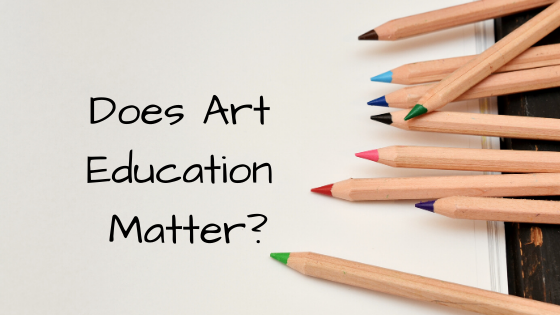The previous posts on this site have shown that the status of art education has slipped over the last few decades. Now we’re going to really delve into why that has happened and what the effects of that slippage are. Then, we will discuss why art education matters at all. Why is art education important? As we will see, the answer to that question is complex and not everyone agrees on it.
There are several reasons why art education used to be taken for granted and is now regularly regarded by many policymakers as nice, but not essential. The first is something we’ve looked at before: the gatekeeper mentality in the arts. I mentioned it first in the post about the current art education landscape in museums. However, this is not just an issue in museums. There is a perception that art is for people with an art background and, related to that, for people of a particular class. The fact that participating in culture can also be expensive adds to this perception. This perception has resulted in lawmakers and parents feeling that their children and schools do not need to learn about these elitist past times.
Related to that is the notion that only certain art is taught in schools and that contributes to class distinctions and furthers prejudice among students1.
The canon of euro-centric classical artworks does exclude many cultures and artistic traditions. It also presents a male dominated history: female artists and art mediums that are associated most with women, such as thread work, are seen as less valuable and become footnotes to art history. It also creates a vicious cycle where more opportunity in schools to view art means students need more schooling to be able to interpret it. Opportunity does not equal access2. We will discuss specific problems and their solutions at length in a future post.
There is also the shifts in the ideologies of general education. Educators have, in the last 30 years or so, begun to focus on inclusiveness. The canon of white male focused art is no longer acceptable as it alienates students who are not represented in that narrow history3. The other shift, which is causing controversy in many different spheres, is the focus on standardized testing. The accusation that teachers are now teaching to the test and are not creating enriching and well rounded curricula is something is an oft heard complaint from politicians, parents, and students. These tests focus on math, writing, and reading. In an environment where teachers are preparing their students only for these tests, there is no room for art education.
Finally, the most important reason that art education has lost its foothold in schools is that there is no consensus on the value that art education gives students. Other subjects that are not on standardized tests, like computer science, have no risk of being struck from the curriculum because they offer skills that can be verified and results that can be quantified. Quantifying the value of art education is something that leaders in the field have struggled with. There are three schools of thought in regards to the value art education has in schools and what it imparts to students. These have been dubbed by Richard Siegesmund as Expressionist, Reconstructivist, and Scientific Rationalism4.
The Expressionist approach to the value of art education focuses on fostering the imagination of a child through creative expression. Art helps children process and acknowledge difficult emotions and creates mentally healthy adults. Additionally, Expressionists say that art recharges and refreshes children before their more rigorous subjects that focus on cognitive thinking. In essence, art has no intrinsic academic value of its own. It aids children in learning the necessary things they must learn in school, like math and vocabulary. And it is, along with recess, an activity in the day that provides children an outlet for their pent up emotions. This ideology fits perfectly with those who think that art education is nice, but not necessary.
Reconstructivists believe that art education molds children into moral and upstanding citizens. Using specific examples, called exemplars by leading Reconstructivist Harry Broudy, educators can teach students the social mores that they will need to navigate society as adults. There are a couple glaring problems that need to be overcome for the Reconstructivist ideology to truly work. The first is that the use of exemplars could lead to a return of a more exclusive education, one where different classes, genders, and cultures are represented differently. The second is that the belief that art is naturally and intrinsically good is false and totalitarian regimes could use and have used art to promote their ideology using the Reconstructivist method. That is not unique to art; biology has been similarly abused by those seeking scientific justification for their racism. The Reconstructivist movement has tried to compensate for these flaws by explaining that the clear, best use of the Reconstructivist ideology is to promote multicultural and democratic ideals. But since it is so easily perverted, it is necessary to clearly define what the goal is for students.
The final ideology is Scientific Rationalism, which is the belief that art education is necessary because it expands literacy. Understanding images requires the ability to read symbolic systems. In essence, art is a tool that teaches students a language they will need when looking at any image whether it is fine art or not. Scientific Rationalists believe that aesthetics is part of cognition and this belief is a necessary component of Scientific Rationalism. If aesthetics is a fundamental part of how we perceive the world, it makes absolute sense that students should learn how to articulate what they are perceiving. The problem here is that this approach hinges on a consensus that aesthetics is a part of cognition. Not believing that would make Scientific Rationalism fall apart.
Siegesmund has his own approach. He calls it Reasoned Perception and it is derived mostly from Scientific Rationalism. Believing that aesthetics are a part of cognition, art education teaches students to reason through perception. As he says, “We apply criteria, we construe knowledge. The role of the artist and poet is to help us to see, to take note, to notice.5”
There is a growing movement to define the value that art education provides. When discussing value, a quantitative approach that can be measured seems most appropriate, so Scientific Rationalism seems the way to go. But it is also necessary to remember that art provides a less tangible value; it lives in the emotional realm as much if not not more than the reasoned one. However, it does seem necessary to move away from arguments and approaches that say art is for art’s sake. We need more than that if art education is to survive in schools.
- Siegesmund, Richard. “Why Do We Teach Art Today? Conceptions of Art Education and Their Justification.” Studies in Art Education 39, no. 3 (1998): 197.9
- DiBlasio, “The Road from Nice to Necessary.”
- Smith, Ralph A. “The Arts in General Education Ideology: Some Critical Observations.” Art Education 36, no. 4 (July 1983): 34.
- Siegesmund, Richard. “Why Do We Teach Art Today? Conceptions of Art Education and Their Justification.” Studies in Art Education 39, no. 3 (1998): 197.
- ibid

